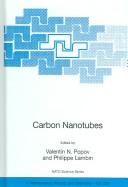| Listing 1 - 1 of 1 |
Sort by
|

ISBN: 9781402045745 1402045727 9781402045721 1402045735 9786611107536 1281107530 1402045743 Year: 2006 Volume: v. 222 Publisher: Dordrecht Springer
Abstract | Keywords | Export | Availability | Bookmark
 Loading...
Loading...Choose an application
- Reference Manager
- EndNote
- RefWorks (Direct export to RefWorks)
It is about 15 years that the carbon nanotubes have been discovered by Sumio Iijima in a transmission electron microscope. Since that time, these long hollow cylindrical carbon molecules have revealed being remarkable nanostructures for several aspects. They are composed of just one element, Carbon, and are easily produced by several techniques. A nanotube can bend easily but still is very robust. The nanotubes can be manipulated and contacted to external electrodes. Their diameter is in the nanometer range, whereas their length may exceed several micrometers, if not several millimeters. In diameter, the nanotubes behave like molecules with quantized energy levels, while in length, they behave like a crystal with a continuous distribution of momenta. Depending on its exact atomic structure, a single-wall nanotube –that is to say a nanotube composed of just one rolled-up graphene sheet– may be either a metal or a semiconductor. The nanotubes can carry a large electric current, they are also good thermal conductors. It is not surprising, then, that many applications have been proposed for the nanotubes. At the time of writing, one of their most promising applications is their ability to emit electrons when subjected to an external electric field. Carbon nanotubes can do so in normal vacuum conditions with a reasonable voltage threshold, which make them suitable for cold-cathode devices.
materiaalkennis --- halfgeleiders --- Electronics and optics of solids --- nanotechniek --- transistoren --- Materials sciences --- Electrical engineering --- materialen (technologie) --- Nanostructured materials --- Nanotubes --- Carbon --- Tubes --- Nanomatériaux --- Carbone --- Congresses --- Congresses. --- Congrès --- EPUB-LIV-FT LIVCHIMI SPRINGER-B --- Materials. --- Engineering. --- Nanotechnology. --- Optical materials. --- Materials Science, general. --- Nanotechnology and Microengineering. --- Structural Materials. --- Optical and Electronic Materials. --- Optics --- Materials --- Molecular technology --- Nanoscale technology --- High technology --- Construction --- Industrial arts --- Technology --- Engineering --- Engineering materials --- Industrial materials --- Engineering design --- Manufacturing processes --- Materials science. --- Structural materials. --- Electronic materials. --- Electronic materials --- Architectural materials --- Architecture --- Building --- Building supplies --- Buildings --- Construction materials --- Structural materials --- Material science --- Physical sciences --- NATO
| Listing 1 - 1 of 1 |
Sort by
|

 Search
Search Feedback
Feedback About UniCat
About UniCat  Help
Help News
News